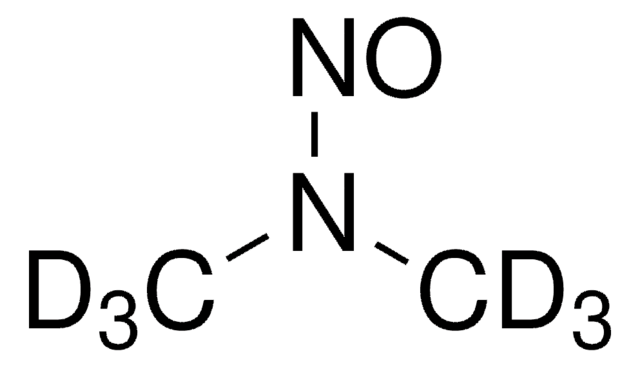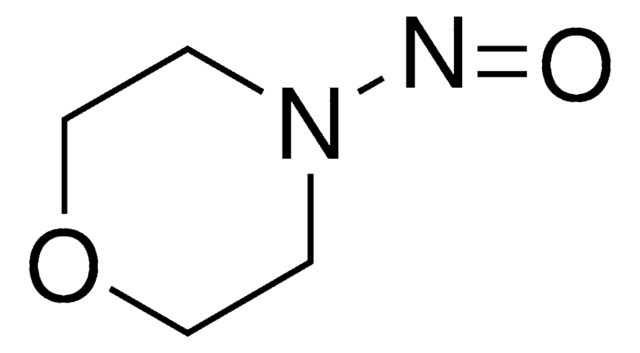73861
N-Nitrosodiethylamine
≥99.0% (GC)
Synonym(s):
Diethylnitrosamine
Sign Into View Organizational & Contract Pricing
All Photos(1)
About This Item
Linear Formula:
(C2H5)2NNO
CAS Number:
Molecular Weight:
102.14
Beilstein:
1744991
EC Number:
MDL number:
UNSPSC Code:
12352100
PubChem Substance ID:
NACRES:
NA.22
Recommended Products
Quality Level
Assay
≥99.0% (GC)
form
liquid
IVD
for in vitro diagnostic use
bp
177 °C (lit.)
density
0.95 g/mL (lit.)
functional group
N-nitroso
amine
nitroso
SMILES string
CCN(CC)N=O
InChI
1S/C4H10N2O/c1-3-6(4-2)5-7/h3-4H2,1-2H3
InChI key
WBNQDOYYEUMPFS-UHFFFAOYSA-N
Looking for similar products? Visit Product Comparison Guide
Related Categories
Application
N-Nitrosodiethylamine can be used as a reactant to synthesize:
- α-Amino oxime derivatives from alkenes via visible-light-induced photoaddition in the presence of HCl.
- Diethylnitrosamine metalloporphyrin complexes from metalloporphyrins in the presence of dichloromethane.
Signal Word
Danger
Hazard Statements
Precautionary Statements
Hazard Classifications
Acute Tox. 3 Oral - Aquatic Chronic 3 - Carc. 1B
Storage Class Code
6.1C - Combustible acute toxic Cat.3 / toxic compounds or compounds which causing chronic effects
WGK
WGK 3
Personal Protective Equipment
dust mask type N95 (US), Eyeshields, Gloves
Choose from one of the most recent versions:
Already Own This Product?
Find documentation for the products that you have recently purchased in the Document Library.
Customers Also Viewed
Changyu Zhu et al.
Journal of hepatology, 74(3), 613-626 (2020-10-11)
The hepatocyte Notch pathway is a pathogenic factor in non-alcoholic steatohepatitis (NASH)-associated fibrosis, but its role in hepatocellular carcinoma (HCC) is less well defined. Herein, we aimed to characterize the molecular and clinical features of Notch-active human HCC, and to
Maria José Rodríguez et al.
International journal of molecular sciences, 21(22) (2020-12-04)
Liver fibrosis is a complex process associated to most types of chronic liver disease, which is characterized by a disturbance of hepatic tissue architecture and the excessive accumulation of extracellular matrix. Resolvin E1 (RvE1) is a representative member of the
L Verna et al.
Pharmacology & therapeutics, 71(1-2), 57-81 (1996-01-01)
N-Nitrosodiethylamine (NDEA) is DNA reactive after bioactivation and produces tumors in every animal species tested. Bioactivation is effected by several P450 isozymes including CYP2E1, which is ethanol inducible. Tumor formation in rat liver was proportional to O4-ethyldeoxythymidine formation in DNA
Esther Bertran et al.
Hepatology (Baltimore, Md.), 58(6), 2032-2044 (2013-07-03)
Transforming growth factor-beta (TGF-β) is an important regulatory suppressor factor in hepatocytes. However, liver tumor cells develop mechanisms to overcome its suppressor effects and respond to this cytokine by inducing other processes, such as the epithelial-mesenchymal transition (EMT), which contributes
Masaaki Miyakoshi et al.
Molecular carcinogenesis, 53(1), 67-76 (2012-08-23)
STAT3 activation is involved in development and progression of hepatocellular carcinoma (HCC). We investigated STAT3 activation during hepatocarcinogenesis induced by neonatal diethylnitrosamine (DEN) treatment in mice. Nuclear accumulation and phosphorylation of STAT3 were detected in altered hepatocyte foci in the
Our team of scientists has experience in all areas of research including Life Science, Material Science, Chemical Synthesis, Chromatography, Analytical and many others.
Contact Technical Service








